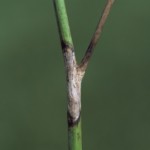National Sclerotinia Initiative
 Sclerotinia (white mold or stem rot) is a fungal disease affecting broadleaf plants such as canola, soybeans, sunflowers, dry edible beans and pulses (dry peas, lentils and chickpeas). It generates hard, black bodies called sclerotia that can remain in soil for many years. Under the right weather conditions, sclerotia produce spores that spread for miles and can infect susceptible crops. The fungus causes serious economic loss by decreasing crop quality and yields. Collective annual losses for U.S. crops participating in the initiative have been as high as $252 million, including $24 million for canola alone.
Sclerotinia (white mold or stem rot) is a fungal disease affecting broadleaf plants such as canola, soybeans, sunflowers, dry edible beans and pulses (dry peas, lentils and chickpeas). It generates hard, black bodies called sclerotia that can remain in soil for many years. Under the right weather conditions, sclerotia produce spores that spread for miles and can infect susceptible crops. The fungus causes serious economic loss by decreasing crop quality and yields. Collective annual losses for U.S. crops participating in the initiative have been as high as $252 million, including $24 million for canola alone.
The National Sclerotinia Initiative was created by a coalition of commodity associations to minimize the devastating effects of this disease on affected crops, including the U.S. Canola Association, American Soybean Association, National Dry Bean Council, National Sunflower Association and USA Dry Pea and Lentil Council. This multi-state, multi-crop research program is administered by the U.S. Department of Agriculture’s Agricultural Research Service. Grant proposals are reviewed by regional research committees.
This competitive research grant program began in 2002 when Congress awarded $960,000 to it for the first time and it has been funded each year since from around $1 million to more than $1.7 million. This is due to many accomplishments, which prove how far research dollars can go. For example, the initiative led to the development of canola cultivars with improved tolerance to sclerotinia.